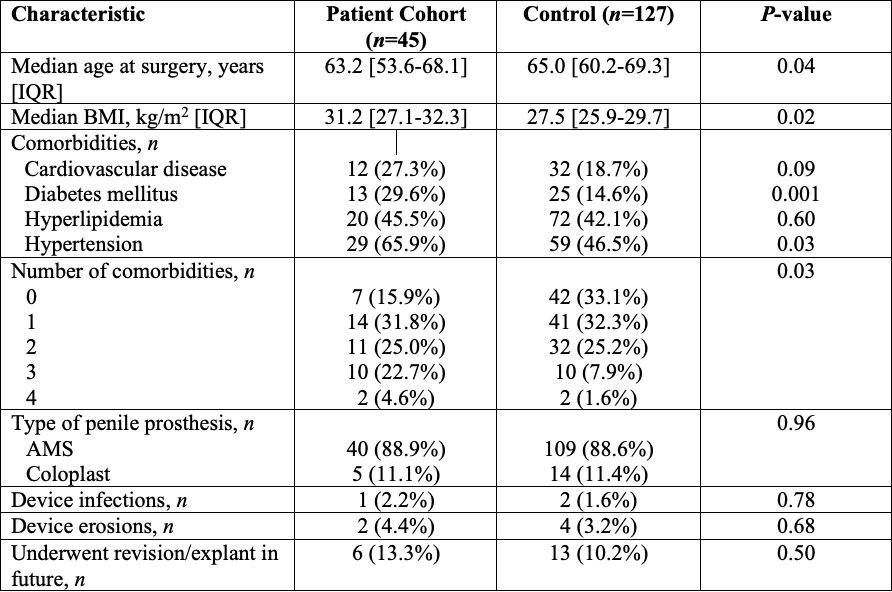Back
Poster, Podium & Video Sessions
Podium
PD28: Sexual Function/Dysfunction: Surgical Therapy I
PD28-10: Concomitant Urologic Procedures During Penile Prosthesis Surgery
Saturday, May 14, 2022
2:30 PM – 2:40 PM
Location: Room 245
Jason Levy*, Ridwan Alam, Baltimore, MD, William Ducomb, Detroit, MI, Arthur Burnett, Baltimore, MD
- JL
Jason Levy, DO
Drexel University College of Medicine / Hahnemann University Hospial
Podium Presenter(s)
Introduction: There is a paucity of literature investigating outcomes for patients who undergo concomitant non-reconstructive urologic procedures at the time of 3-piece inflatable penile prosthesis (IPP) placement. Our aim is to analyze outcomes including risk factors, complications, and procedure types for patients who underwent IPP placement with concomitant non-reconstructive urologic procedures at a high-volume institution.
Methods: A retrospective IRB approved (IRB00205900) review of patients undergoing IPP placement at Johns Hopkins from January 2007-July 2021 was conducted. We identified 330 patients who underwent IPP placement and a concomitant urologic procedure. We excluded patients who had concomitant penile straightening procedures, artificial urinary sphincter (AUS), and reconstructive penile procedures. The remaining cohort included 45 patients who had a non-reconstructive urologic procedure done concurrently. A control group of 127 patients who underwent IPP placement after 2015 with no concomitant procedures was utilized. All patients underwent penoscrotal approach.
Results: Concomitant procedure type was divided into endourology (n=24; 53.3%), penile (n=9; 20.0%), scrotal (n=10; 22.2%), neuromodulation (n=1; 2.2%), and oncologic (n=1; 2.2%). Compared to the control group, patients in the concomitant group were younger (p=0.04) but more overweight (p=0.02) and less healthy, as measured by comorbidities (p=0.03). Between the two groups (Table 1), there was no significant difference in device infections (concomitant 2.2% vs control 1.6%, p=0.78) or device erosions (4.4% vs 3.2%, p=0.68). There was no difference in the proportion of patients requiring future IPP revision (13.3% vs 10.2%, p=0.50).
Conclusions: This retrospective analysis demonstrates the largest cohort of patients undergoing non-reconstructive urologic procedures at the time of IPP placement. Our results demonstrate that concomitant non-reconstructive procedures confer no increased risk of prosthetic adverse events, regardless of procedure type.
Source of Funding: None

Methods: A retrospective IRB approved (IRB00205900) review of patients undergoing IPP placement at Johns Hopkins from January 2007-July 2021 was conducted. We identified 330 patients who underwent IPP placement and a concomitant urologic procedure. We excluded patients who had concomitant penile straightening procedures, artificial urinary sphincter (AUS), and reconstructive penile procedures. The remaining cohort included 45 patients who had a non-reconstructive urologic procedure done concurrently. A control group of 127 patients who underwent IPP placement after 2015 with no concomitant procedures was utilized. All patients underwent penoscrotal approach.
Results: Concomitant procedure type was divided into endourology (n=24; 53.3%), penile (n=9; 20.0%), scrotal (n=10; 22.2%), neuromodulation (n=1; 2.2%), and oncologic (n=1; 2.2%). Compared to the control group, patients in the concomitant group were younger (p=0.04) but more overweight (p=0.02) and less healthy, as measured by comorbidities (p=0.03). Between the two groups (Table 1), there was no significant difference in device infections (concomitant 2.2% vs control 1.6%, p=0.78) or device erosions (4.4% vs 3.2%, p=0.68). There was no difference in the proportion of patients requiring future IPP revision (13.3% vs 10.2%, p=0.50).
Conclusions: This retrospective analysis demonstrates the largest cohort of patients undergoing non-reconstructive urologic procedures at the time of IPP placement. Our results demonstrate that concomitant non-reconstructive procedures confer no increased risk of prosthetic adverse events, regardless of procedure type.
Source of Funding: None


.jpg)
.jpg)